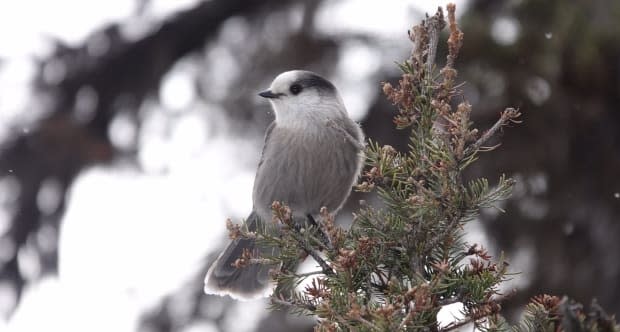Why the Canada jay's friendly begging for food is an evolutionary winter survival tactic

Most people in Canada recognize one of the country's most common birds, the Canada jay or grey jay.
They are one of the few birds that stick around all winter, and if you've headed out for a winter walk, or sat out in a well-treed backyard, you've seen their soft, fluffy plumage and familiar blue-grey colour, and probably noticed their friendly manner.
In February, Canadian Geographic magazine featured Canada jays on its front cover and included an article as to why the Canada jay should become Canada's national bird.
But earlier this week, CBC listener David Wortman wrote in to ask naturalist Brian Keating a question: Where have all the grey jays gone?
"He said in all our cross-country skiing and lunching in Banff in Canada, we've only seen the lovable grey jay moochers once in the last couple of years, Keating told The Homestretch.
"They're basically the characteristic bird of Canada's north woods," Keating said. "They've got that extreme tameness … they're Canadian, they're polite. They've got a habit of seeking us out for handouts."
For the answer, Keating reached out to local bird expert and biologist Chris Fisher, the author of of Birds of Alberta.
Fisher pointed to a study in Ontario's Algonquin Provincial Park, which showed a decline of 50 per cent of the bird population during the past 30 years.
Thinking about Alberta, Fisher looked up the long-term results from the Alberta Breeding Bird Survey in data books from 1971 to 2015 — and found Alberta's grey jay population has decreased 35 per cent.
Researchers theorize it's all about climate conditions in the fall and winter.
"Where that is a problem for the grey jay is it damages their caches of perishable food," Keating said. "These grey jays have this incredible ability to survive our cold winters because they've become what's called a scatter hoarder — they hide their food during times of food excess, and then they find it again months later, which is usually in the dead of winter."

Grey jays have great memories for remembering where they left their stash. They create the caches by making use of their extra-large saliva gland, which extends from the corner of their beak inside their head all the way to the back of the head.
"Basically, it's sticky, gooey spit. And they cover their food bits with it and they stick it in hiding places, usually up in the trees, away from the snow line so they don't lose it."
The gooey spit creates what Keating calls a natural Ziploc bag to hide their food inside. They also use the goo to help line their winter nests with fur salvaged from deer and elk carcases.
"So in this way, they can feed their youngsters in the middle of winter in February and March," Keating said. "But with climate change, the freeze-thaw doesn't keep their food stash fresh, and the researchers are theorizing that their food is going rotten."
This time of year, grey jays will be raising their little ones.
"They would have laid four eggs in a nest last March, and the youngsters would have hatched out earlier this month," Keating said. "The parents feed them from their stashed supplies. And the parents will also be looking for — just like the grizzly bears, which will also be coming out right about now — they'll be looking for winter kills melting out of the snow, which will give them a nice food benefit."
Besides foraging and stashing, Canada jays have one last survival tactic — following larger mammals.
"Following hikers and skiers is actually a genetically programmed strategy that they have evolved to follow big mammals, including people, because we often lead them to food," Keating said.
"Think of the trapper baiting traps, but better yet, think of wolves or coyotes or cougars. These birds will follow those animals, too, because if you follow them long enough, they're going to take you to something that's dead."

The begging behaviour may be on the decline, Keating said, because people are now less likely to feed the wildlife.
"Back when they were more commonly fed in our national parks, people would stop beside a road, a grey jay would appear they would feed it. And so people had this perceived idea that the grey jays were actually more common than they really are," Keating said.
"We've been educating people not to feed wild animals. And so there's probably not as many being fed out there in the bush. You know, they really are truly one of a kind with that kind of behaviour in Canada. That makes them a pretty special bird."
For more fascinating stories about Alberta's wildlife from naturalist Brian Keating, visit his website and check out these stories:
With files from The Homestretch.

 Yahoo Finance
Yahoo Finance 